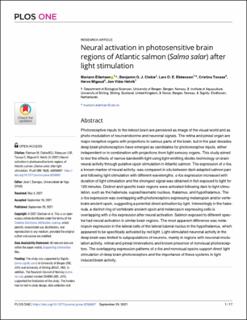| dc.contributor.author | Eilertsen, Mariann | |
| dc.contributor.author | Clokie, Benjamin G.J. | |
| dc.contributor.author | Ebbesson, Lars | |
| dc.contributor.author | Tanase, Cristina | |
| dc.contributor.author | Migaud, Herve | |
| dc.contributor.author | Helvik, Jon Vidar | |
| dc.date.accessioned | 2022-04-20T12:23:39Z | |
| dc.date.available | 2022-04-20T12:23:39Z | |
| dc.date.created | 2021-09-30T15:14:11Z | |
| dc.date.issued | 2021 | |
| dc.identifier.citation | PLOS ONE. 2021, 16 (9), 1-17. | en_US |
| dc.identifier.issn | 1932-6203 | |
| dc.identifier.uri | https://hdl.handle.net/11250/2991645 | |
| dc.description.abstract | Photoreceptive inputs to the teleost brain are perceived as image of the visual world and as photo-modulation of neuroendocrine and neuronal signals. The retina and pineal organ are major receptive organs with projections to various parts of the brain, but in the past decades deep brain photoreceptors have emerged as candidates for photoreceptive inputs, either independent or in combination with projections from light sensory organs. This study aimed to test the effects of narrow bandwidth light using light-emitting diodes technology on brain neural activity through putative opsin stimulation in Atlantic salmon. The expression of c-fos, a known marker of neural activity, was compared in situ between dark-adapted salmon parr and following light stimulation with different wavelengths. c-fos expression increased with duration of light stimulation and the strongest signal was obtained in fish exposed to light for 120 minutes. Distinct and specific brain regions were activated following dark to light stimulation, such as the habenula, suprachiasmatic nucleus, thalamus, and hypothalamus. The c-fos expression was overlapping with photoreceptors expressing melanopsin and/or vertebrate ancient opsin, suggesting a potential direct activation by light. Interestingly in the habenula, a distinct ring of vertebrate ancient opsin and melanopsin expressing cells is overlapping with c-fos expression after neural activation. Salmon exposed to different spectra had neural activation in similar brain regions. The most apparent difference was melanopsin expression in the lateral cells of the lateral tuberal nuclus in the hypothalamus, which appeared to be specifically activated by red light. Light-stimulated neuronal activity in the deep brain was limited to subpopulations of neurons, mainly in regions with neuronal modulation activity, retinal and pineal innervations and known presence of nonvisual photoreceptors. The overlapping expression patterns of c-fos and nonvisual opsins support direct light stimulation of deep brain photoreceptors and the importance of these systems in light induced brain activity. | en_US |
| dc.language.iso | eng | en_US |
| dc.rights | Navngivelse 4.0 Internasjonal | * |
| dc.rights.uri | http://creativecommons.org/licenses/by/4.0/deed.no | * |
| dc.title | Neural activation in photosensitive brain regions of Atlantic salmon (Salmo salar) after light stimulation | en_US |
| dc.type | Peer reviewed | en_US |
| dc.type | Journal article | en_US |
| dc.rights.holder | © 2021 Eilertsen et al. | en_US |
| dc.description.version | publishedVersion | en_US |
| cristin.ispublished | true | |
| cristin.fulltext | original | |
| cristin.qualitycode | 1 | |
| dc.identifier.doi | 10.1371/journal.pone.0258007 | |
| dc.identifier.cristin | 1941556 | |
| dc.source.journal | PLOS ONE | en_US |
| dc.source.volume | 16 | en_US |
| dc.source.issue | 9 | en_US |
| dc.source.pagenumber | 1-17 | en_US |
| dc.relation.project | Norges forskningsråd: 254894 | en_US |

